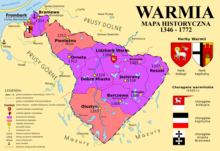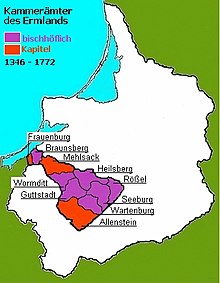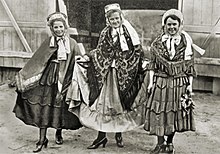Warmia
The Warmia (Prussian, Polish and Latin Warmia ) was first a Prussian settlement area, after the conquest by the Teutonic Order in the 13th century a diocese within the Teutonic Order state . After the Second Peace of Thorn in 1466, when the Teutonic Order state Prussia was divided as the prince-bishopric of Warmia, it came to the autonomous Prussian Royal Share , which had voluntarily submitted to the sovereignty of the Polish crown. In the course of the first partition of Poland in 1772, Warmia became part of the Kingdom of Prussia . Until 1945 the region belonged to the German Empire .
The most important town in this landscape was Braunsberg , as was Balga Castle . Most of the Warmia belonged to the province of East Prussia until 1945 . After the Second World War , the region was placed under Polish administration in the Potsdam Agreement , and the population was then expelled . On March 15, 1991, the Two-Plus-Four Treaty came into force, with which the factual affiliation of Warmia to Poland was also confirmed under international law. The region is now part of the Polish Warmian-Masurian Voivodeship .
The first written mention of "Warmia" comes from the year 1249. The name can be put in Prussian wormyan, warmun "red". It was called “Wormeland” in 1262, and only in 1299 did the term “Ermelandt” appear. This is the German name of the Prussian landscape.
According to legend, Warmo was the ninth son of King Widowuto , who received the land on the Nava (Mariensee) and the Bassora (Passarge). He built a fortress that he called Tolo. According to legend, the German name Ermland goes back to "Ermia", the wife of Warmo.
geography
The area of the Diocese of Warmia extended until 1945 from a narrow coastal strip of the Frischer Haff between Frauenburg and Braunsberg in a south-easterly direction to the Masurian Lakes around Allenstein (Olsztyn) and Rößel (Reszel) . It comprised what is now the Polish part of East Prussia between the Prussian Oberland in the southwest, Natangen and Barten in the north and Masuria in the southeast. The most important rivers are the Passarge (Pasłęka) and the Alle (Łyna) . The diocese covered an area of 4249 km² and was divided from north to south into the chamber offices of Frauenburg, Braunsberg, Mehlsack, Heilsberg, Wormditt, Guttstadt, Rößel, Seeburg, Wartenburg and Allenstein.
The following cities, which were all founded in the Middle Ages, belonged to the diocese (enumerated from the coast into the interior, according to the settlement in the Middle Ages): Frauenburg, Braunsberg, Mehlsack , Wormditt , Guttstadt , Heilsberg , Bischofstein , Rößel , Seeburg , Bischofsburg , Wartenburg and Olsztyn , today the largest city in Polish East Prussia and the voivodeship capital.
population
In the 13th century, the later Warmia was populated by the indigenous Prussian tribes of the Warm (in the northwest), Pogesans and Gallindians (in the south), and Natanger and Barten in the (northeast). After the territories were conquered by the Teutonic Order , they brought colonists from Germany, who settled the country from the coast towards the interior. The two Warmian towns on the Baltic Sea, Frauenburg and Braunsberg , were founded by settlers from Lübeck (Fleming family) after the last great Prussian uprising in the 1270s , while colonists settled in central Warmia, which was only opened up in the first half of the 14th century Silesia moved in, whose peculiar dialect, the so-called "Breslau", survived into the 20th century (the "Silesian" cities of Warmia were Wormditt , Guttstadt and Heilsberg ). At the latest, in the second half of the 14th century, the southern chamber offices of Allenstein , Wartenburg , Seeburg , Rößel and Bischofsburg were repopulated. In addition to the Prussian villages, there were new colonists founded. The native Prussians were treated in an exemplary manner in Warmia for the time. Both the bishop in his residence in Heilsberg and the cathedral chapter in Frauenburg ran priestly schools for the Prussians. At the episcopal court in Heilsberg, Prussians were also employed as followers of the bishop, sometimes in high positions.
The Prussian language, however, died out in Catholic Warmia in the 16th century. In the neighboring Evangelical Duchy of Prussia, Albrecht von Brandenburg-Ansbach-Prussia used the Prussian language and had translations made and pastors trained in the language.
The wars of the 15th century devastated southern Warmia in particular and resulted in great population losses. In the late 15th and 16th centuries, however, due to the conditions there ( religious wars ), it was hardly possible to win settlers from Germany . Therefore, the Warmia administration tried to attract immigrants from the neighboring country of Prussia, the Polish Mazovia . These formed an own Warmian dialect of the Polish language , which was predominant in the south-eastern Warmia in the country, especially in the former district of Allenstein . This dialect survived even the time of the Third Reich , but not the People's Republic of Poland.
However, the minority of the Polish-speaking foreigners did not feel they belonged to the Polish nation as such after the fall of Old Poland in 1795 . They were loyal subjects of the prince-bishop and the cathedral chapter of Warmia and later, above all, of the German kings of Prussia . In the referendum of 1920, a large majority of them voted for southern Warmia to remain with East Prussia. In the period between the two world wars, several Polish-speaking village schools existed under the protection of the German state in southern Warmia. However, when National Socialist Germany attacked Poland on September 1, 1939, the Polish-speaking schools were closed and numerous Polish activists and teachers were arrested. Many subsequently perished in the National Socialist concentration camps .
After 1945, many Polish-speaking foreigners also left their homeland as expellees and as late repatriates for the Federal Republic of Germany or - in individual cases - the GDR . Many of them were able to move to the Rhineland via Schleswig-Holstein with the support of Bishop Kaller and, as part of a major campaign, to the former Ahrbrück air force training area , on whose grounds several Warmian settlements were built, including in Dennbach Valley.
history
Order state
Warmien was conquered by the order of knights from Marienwerder: Elbing fell in 1237, Braunsberg and Balga in 1239. With his Bull of Rieti of August 3, 1234, Pope Gregory IX. after successful missionary work and conquest, the land of the Prussians gave the Grand Master of the Teutonic Order "eternal and free possession". However, the Holy See reserved the spiritual administration for itself and so on July 29, 1243 Pope Innocent IV commissioned the legate Wilhelm von Modena to establish four dioceses in the Prussian part of the Order: Warmia, Kulm, Pomesania and Samland. The names of the dioceses were based on the old Prussian landscapes.
The priest Anselm was ordained the first bishop of Warmia in 1250 . According to the papal regulation, two thirds of the chamber offices were available to him for secular rulership, and he chose the offices of Braunsberg, Heilsberg, Wormditt, Guttstadt, Rössel, Seeburg and Wartenburg. The cathedral chapter exercised sovereign power over the other three offices, the 16 spiritual members of which were appointed by the bishop as the spiritual head of the entire diocese. The seat of the chapter was initially in Braunsberg, from 1284 in Frauenburg. The first bishop's seat was in Wormditt from 1341 to 1350, after which the bishops resided in Heilsberg Castle until 1795. During the Prussian period (1795 to 1945) Frauenburg was the seat of a bishopric.
Principality
Main article: Principality of Warmia
The Principality of Warmia ( Polish Biskupie Księstwo Warmińskie ) was the secular rule of the Bishops of Warmia in their capacity as princes of Warmia within the Teutonic Order State .
The diocese as such was founded by the papal legate Wilhelm von Modena in the course of the conquest of Prussia by the Teutonic Order (OT) in 1243 ; the title of Prince-Bishop is attributed to Emperor Charles IV . In the late Middle Ages, the secular territory of the bishops also developed.
After the Second Peace of Thorn in 1466, it came to the autonomous Prussia Royal Share , which had voluntarily submitted to the sovereignty of the Polish crown. In the course of the first partition of Poland in 1772, it was secularized and part of the Kingdom of Prussia .
Reformation time
In 1525 the religious state was secularized and accepted the Lutheran creed. The episcopal government of Warmia, on the other hand, adhered strictly to the Catholic faith. Bishop Mauritius Ferber obtained a decree prohibiting non-Catholics from permanent residence in the diocese. Under Bishop Lucas Watzenrode , the prince-bishopric , which had been under the church of the Archbishop of Riga, was exempt. H. subordinated directly to the Holy See, which it remained until the 20th century. The Warmian prince-bishop Stanislaus Hosius (1551–1579) was the main initiator of the Counter-Reformation in Poland. He founded the Lyceum Hosianum , which was to become a backbone of the Warmia priestly education, and promoted the Heiligelinde monastery .
Modern times
During the 2nd Swedish-Polish War (1655–1660), the Swedish King Karl Gustav granted the Warmia for a short time complete independence from Poland as a secular prince-bishopric, but with the Peace of Wehlau (1657) Poland succeeded in regaining supremacy over the Warmia . The country of Warmia suffered the complete loss of its sovereignty in 1772 with the 1st partition of Poland , in the wake of which it fell to the Kingdom of Prussia . The protest of the last Prince-Bishop Ignatius Krasicki with the Pope was unsuccessful. The diocese of Warmia remained exempt.
With the transition of Warmia to Prussia, the diocese lost the status of a prince-bishopric and Warmia was only the name of a diocese. The name went under in the state administration, the Warmia was divided into the Prussian districts Braunsberg , Heilsberg , Rößel and Allenstein .
With almost complete population exchange, the diocese (Episcopatus Warmiensis) survived as an institution the change from German to Polish sovereignty after 1945, but from 1946 to 1972 under provisional administration by vicars and apostolic administrators. Maximilian Kaller , the last German bishop of Warmia, was initially persuaded by the German authorities to flee to the West when East Prussia was conquered by the Soviet Red Army . On his own, however, he returned to his diocese after the fighting had ceased. Subsequently, however, he was forced by the Primate of Poland Cardinal August Hlond to give up his office. In 1946 he was appointed by Pope Pius XII. appointed bishop with special, cross-diocese powers for the pastoral care of displaced persons . He devoted himself to a. the establishment of an Ermlandhaus as a contact point for the expelled Ermländer (first in Rulle , then on Gut Honeburg near Osnabrück-Haste , since 1961 in Münster ) and the Young Ermland community (Gje). In 1992 Warmia was elevated to an archbishopric. Warmia also returned politically in the form of a voivodeship, from 1999 as Warminsko-Mazurskie , German Warmia-Masuria .
Personalities
- Nicolaus Copernicus , astronomer, mathematician, doctor, canon and administrator
- Daniel Bärholz , baroque poet
- Regina Protmann , founder of the Catherine Sisters , Blessed
- Erich Mendelsohn , architect
- Hans-Jürgen Wischnewski , politician ( SPD )
- Hugo Haase , politician ( SPD and USPD )
- Georg Hermanowski , writer, journalist
- Georg Sterzinsky , Cardinal and Archbishop of Berlin
- Gerd-Helmut Komossa , MAD boss from 1977 to 1980
- Rainer Barzel , politician ( CDU )
- Hartmut Bagger , General and Inspector General of the Bundeswehr
- Hans Kramer , head forester and master elk hunter
- Wolf Lepenies , sociologist, science politician and academic writer
- Feliks Nowowiejski , composer and conductor
- Hermann Ganswindt , rocket pioneer and inventor
- Ernst Josef Fittkau , zoologist
- Gerhard Fittkau , theologian
- Friedrich Ernst Dorn , physicist
- Eva Maria Sirowatka , writer
- Eugen Drewello , administrative lawyer
- Arthur Kather , vicar capitular
- Josef Felix Pompeckj , paleontologist and geologist
- Adrian Kasnitz , writer
- Klaus-Joachim Zülch , neuroscientist
- Wolfgang Gesemann , Balkanologist
- Josef Engling , member of the Schoenstatt Movement
- Stephan Foremny , composer and choir director
- Brigitte Poschmann , archivist and historian
- Alois Bulitta , economist, Slavist, school administrator and non-fiction author
- Arno Bulitta , physician, expellee and local politician
- Franz Bulitta , clergyman , cath. Pastor in Willenberg , Episcopal Commissioner
- Josef Bulitta , lawyer, founder of “Aktion fürs das Leben”, non-fiction author
- Hermann Wischnat , poet and teacher
- Johann Heinrich Schmülling (1774–1851), director of the royal Catholic grammar school in Braunsberg and professor of philosophy at the Lyceum Hosianum
Some of the most famous personalities on the Warmia bishopric were Lucas Watzenrode , the uncle of the astronomer Nicolaus Copernicus , and Enea Silvio Piccolomini, who later became Pope Pius II. The historian and scholar Martin Cromer as well as one of the most important figures and co-founder of the European should also be mentioned Counter-Reformation at the Council of Trent , Cardinal Stanislaus Hosius .
Have ancestors from Warmia:
- Rainer Maria Woelki , Cardinal and Archbishop of Cologne
- Horst Eberlein , auxiliary bishop in Hamburg and titular bishop of Tisedi
- Winfried Kretschmann , Prime Minister of Baden-Württemberg
- Stefan Zekorn , auxiliary bishop in Münster
- Petra Reski , journalist and book author
- Paul Hoppe , Capitular Vicar
- Isolde Hausser , physicist
- Matthias Foremny , conductor and university professor
See also
- Teutonic Order State
- Archdiocese of Warmia
- Braunsberg district
- Heilsberg district
- Olsztyn district
- Circle Rößel
- List of the bishops of Warmia
- East Prussia
- Prussia
literature
- Hermann Frischbier : Prussian dictionary. East and West Prussian provincialisms in alphabetical order . 2 volumes. Enslin, Berlin 1882–1883, (also reprographic reprint: Olms, Hildesheim 1971), vol. 1, p. 293.
- Joseph Bender : The old Prussian landscapes within the Warmia diocese . In: Zeitschrift für die Geschichte und Altertumskunde Ermlands , Volume 2, year 1861–1863, Mainz 1863, pp. 359–386 ( full text ).
- Andreas Thiel : Contributions to the constitutional and legal history of Warmia. From the beginning of the same until its attack under Polish rule ( Peace of Thorn 1466 ) . In: Zeitschrift für die Geschichte und Altertumskunde Ermlands , Volume 3, year 1864–1866, Braunsberg 1866, pp. 662–688 ( full text )
- Map of Warmia from 1755
- Timeline of the Warmian history
- Andrzej Kopiczko: The Latest History of the Diocese of Warmia in Polish Historiography after 1945 . In: Religious and Cultural History in East Central and Southern Europe , edited by Rainer Bendel . Volume 2, LIT Verlag, Berlin 2006, ISBN 3 8258 6178 3 , pp. 139–152 ( limited preview )
- Scriptores rerum Warmiensium (edited by Karl Peter Woelky and Johann Martin Saage ). Volume 1, Braunsberg 1866 ( full text ).
- George Adalbert von Mülverstedt : The names Ermeland and Warmien. The heath castles of the Bartergau. Heinrich von Sorbaum, Bishop of Ermeland. In: Preußische Provinzial-Blätter , year 1857 (= Neue Prussische Provinzial-Blätter , Volume XI), Königsberg 1857, pp. 65–73 , pp. 179–198 and pp. 283–296.
Web links
Individual evidence
- ^ Community Young Warmia , accessed on October 28, 2019.




